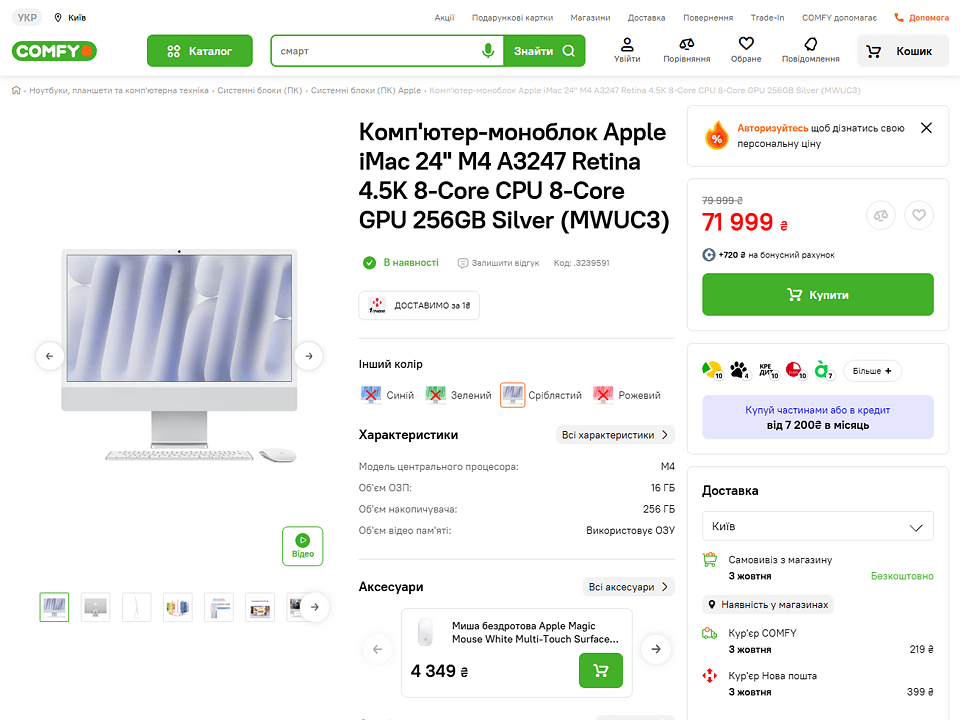Seamless AWS migration delivering scale and resilience for e-commerce
Learn how one of Ukraine’s top e-commerce players transformed its business with an AWS cloud migration.

COMFY is Ukraine’s leading omnichannel retailer in electronics and home appliances, with 113 stores across 50+ cities, serving over 11.5 million customers and offering 150,000+ products. With a 25% market share and the top-five largest Internet players on the Ukrainian market for years, they’ve become a household name. Founded in 2005, COMFY has grown into a powerhouse, not just in retail, but as a workplace of choice. With over 5,200 employees, it ranks among Ukraine’s 20 best employers and is one of the country’s 100 largest taxpayers.
Reliability is a critical concern for any business provider, but at COMFY’s scale, resilience isn’t optional – it’s mandatory.
To provide uncompromised business continuity and hardened operational resilience on a future-proof foundation built for performance, availability, and scale, COMFY decided to make a strategic move to AWS and turned to AWS partner Chaos Gears for guidance throughout the migration journey.
Solution Embracing scale by simplifying infrastructure
In a fast-changing market, ongoing stability issues and ever-increasing architectural complexity — as is common with bespoke in-house solutions — can turn into an anchor dragging down ability to innovate. These challenges need to be addressed early, especially in e-commerce, where milliseconds impact revenue and customer expectations shift daily.
Yet, too much focus on a fast time-to-market is often mired with its own issues that prevent an equally fast time-to-value. In order to be successful from conception to production, migrations have to follow prudently planned strategies which are as resilient to the unforeseen, as the outcomes they seek to bring about.
Reading through Chaos Gears’ cloud migration case studies you might notice that all of them follow a similar schema, despite being anchored in different verticals and business needs. One of the reasons for that similarity is precisely the dilemma mentioned above: how can one reconcile short migration timeframes with quality and resilience?
The cloud itself is part of the answer, but to get there in the first place, we adhere to industry-proven frameworks and navigate them based on our extensive experience. Best practices meet practical flexibility tailored to our customer’s needs.
One of COMFY’s needs was a common one: a decrease of its mounting TCO. But there can be no surgical cure without the right diagnosis.
At this early stage, Chaos Gears evaluated the retailer's existing infrastructure to determine its cloud readiness and assess all functional components. This included a comprehensive risk analysis, covering business, technical and process risks.
This data then helped shape our future scope of work and formed the basis for all cost projections to help determine the most effective cost optimization opportunities and inform COMFY’s business continuity plans and testing strategy.
One of the key factors of this project’s success — apart from technical expertise and close collaboration between the teams — was a proper understanding of business needs, project objectives, and priorities.
This allowed us to make the right technical decisions, select the appropriate approaches, tools, and solutions to achieve the business goal, and to remain fully focused on delivering high value to the client and its end users as quickly as possible.
Once all stakeholders were content with the numbers, pilots and PoCs followed as we secured extra funding for our client thanks to our AWS partnership and the AWS Migration Acceleration Program (MAP).
Communication between our teams remained tight from the very onset of our cooperation and knowledge flowed freely — a hallmark that Chaos Gears prides itself on. With a landing zone fully set up and all stakeholders on board, it was time to work on the implementation.
Resilient scaling
Most of the work we had ahead of us was centered around COMFY’s extensive e-commerce dataset. This meant not only efficiently accommodating and securing numerous different data sources that had already been aggregated in the past, but also opening the doors for countless future innovation opportunities that could tap into this data.
In comparison, the actual backbone of COMFY’s new cloud presence is driven by a modern, albeit relatively standard setup: Amazon’s Elastic Kubernetes Service working in tandem with ArgoCD (acting as a Kubernetes controller and responsible for our partner’s CI/CD pipelines).
With such a containerized, microservice-focused infrastructure, the ecommerce giant is in great shape to scale its resources seamlessly, maintaining consistent performance and an optimal cost footprint by automatically adjusting to actual demand — typically to traffic spikes during seasonal events or sales, which are a common problem in the e-commerce space.
This architectural decoupling also helps ensure the high availability of the retailer’s entire platform as the impact of potential faults is minimized and contained to small, isolated services. And while COMFY does not yet offer its services across state boundaries, this option is now on the table as well — with drastically less costs and complexity, including multi-regional deployments that are a breeze thanks to AWS’ global infrastructure.
In order to minimize friction and let the retailer maintain normal operations throughout the replication and migration of its services, we helped the process along with AWS’ proven Application Migration Service, primarily covering numerous standalone services running on dedicated EC2 instances.
Flexible data flows
COMFY’s extensive data catalogue is where Chaos Gears had to roll up its sleeves. With databases and files scattered across on-prem and hybrid cloud solutions, we opted to smooth several rough edges with readily available AWS migration tools that perfectly complement its Application Migration Service: AWS Database Migration Service and AWS DataSync.
Together with our partner we were also able to isolate several data dependencies, so that part of the migration could happen offline, without disrupting COMFY’s retail platform at all. In particular, this included numerous large databases retaining billions upon billions of message and transaction logs.
The remainder of the migration needed to happen online, however, in parallel to normal operations. This is where AWS Database Migration Service helped us port the platform’s MongoDB databases — primarily containing the entire product catalogue along with multilingual customer reviews — to Amazon’s DocumentDB.
It is a natural choice, given its API is fully compatible with our partner’s existing MongoDB connectors, further shaving off the ever-precious time-to-market of the project, without any sacrifices.

With all document storage taken care of, we also needed to tackle the platform’s relational data — and opted for a fairly routine mix of Amazon Aurora and Amazon RDS instances.
During this stage, we helped COMFY’s engineers diagnose and fix several performance bottlenecks which surfaced between its services and databases along the way.
While APIs and the external shapes of software may be fully interchangeable and appear identical from the outside, internal details can vary between them subtly (and sometimes not-so-subtly). And that’s excluding the impact of other major factors (hardware, for one). Oftentimes those differences are not actually the cause of new issues — instead, they reveal existing issues in the software that depends on them.
As those bottlenecks surfaced, we identified and helped remove several root causes of deadlocks happening during transactional operations between COMFY’s services and its databases. Fully ACID operations are, of course, critical to any service dealing with sensitive data — such as monetary purchases in this case — so extra care must be taken to ensure this layer of resilience does not straight out halt all performance under high concurrency loads.
Our work on COMFY’s databases also involved a deep review of all its storage models, but we focused on optimizing relational indices in particular, given they tend to be a common source of performance issues, but often involve fairly low-hanging fruit.
In contrast to low-hanging fruit, we also needed some extra time on our partner’s file storage. While AWS DataSync let us jump ahead when moving COMFY’s existing files from NFS to Amazon’s EFS cloud storage, EFS’ performance characteristics (most prominently: its latency) proved insufficient for COMFY’s production needs. Adjusting the migration course accordingly, we evaluated all existing options and opted for a course correction towards an FSx for OpenZFS solution instead — at least for performance-critical files that need to reside in networked storage.
Local storage on run-of-the-mill EBS volumes also caused a few surprising performance headaches along the way. Our teams encountered microbursting (i.e. hardware throttling) issues happening with COMFY’s workloads, but to fix those, one first has to reveal and diagnose them — and properly configured CloudWatch metrics helped greatly.
As is often the case, a simple hardware upgrade ended up being the natural remedy to a performance problem, being orders of magnitude cheaper than the alternative, which would’ve required a complex codebase refactoring. A switch to fast NVMe-backed instance store volumes therefore did the trick, showcasing yet another major advantage of the cloud.
Now imagine if the same problem surfaced on-prem.
Outcome Timely services deliver timely products
Despite considerable time pressure caused by mounting performance and reliability issues within the client’s existing infrastructure, our combined teams managed to fully deliver on all set goals.
COMFY’s new online headquarters scale dynamically in both directions, vertically and horizontally, giving the retail giant the necessary means to bring new ideas to market much more quickly and flexibly than before.
With a considerably reduced TCO, the company has gained extra breathing room where infrastructure and operational costs are concerned. This reduced TCO also comes with an increase in overall performance — which may seem counterintuitive at first, but is in fact a typical outcome for cloud migrations performed with expert AWS partners, such as Chaos Gears.
Our client’s clients, in turn, also benefit from those performance improvements throughout the entire platform, but most notably the retailer’s website with its e-commerce frontend. This better user experience is coupled with higher availability as well.
But just as customers won’t know the platform has migrated to the cloud, given the process was seamless, they won’t know it’s more reliable either — only that the retailer’s services are never offline.
Migrating to AWS with Chaos Gears has been a true partnership experience. Their team not only guided us through the complexity of cloud transformation but also kept our business priorities front and center.
Thanks to their expertise, we now have a resilient, scalable foundation that allows COMFY to innovate faster and deliver an even better experience to our customers.
We remain committed to ensuring it remains as such, helping along COMFY’s success within the AWS cloud as we continue our cooperation with our partner’s expert teams.
Core tech
Amazon EC2
Amazon Elastic Kubernetes Service
AWS Application Migration Service
AWS DataSync
AWS Database Migration Service
Amazon RDS
Amazon Aurora
Amazon DocumentDB
Amazon EFS
Amazon FSx for OpenZFS
Amazon EBS
Amazon CloudWatch
ArgoCD